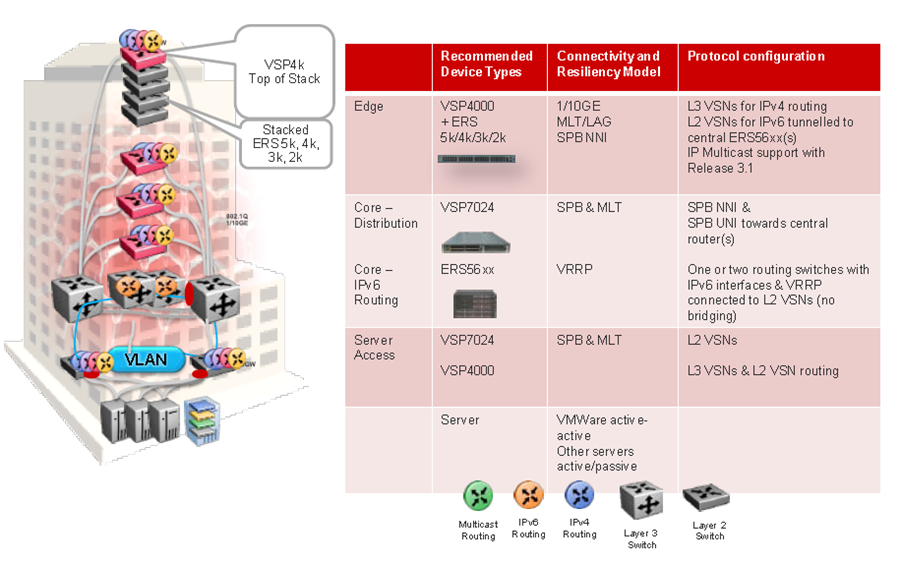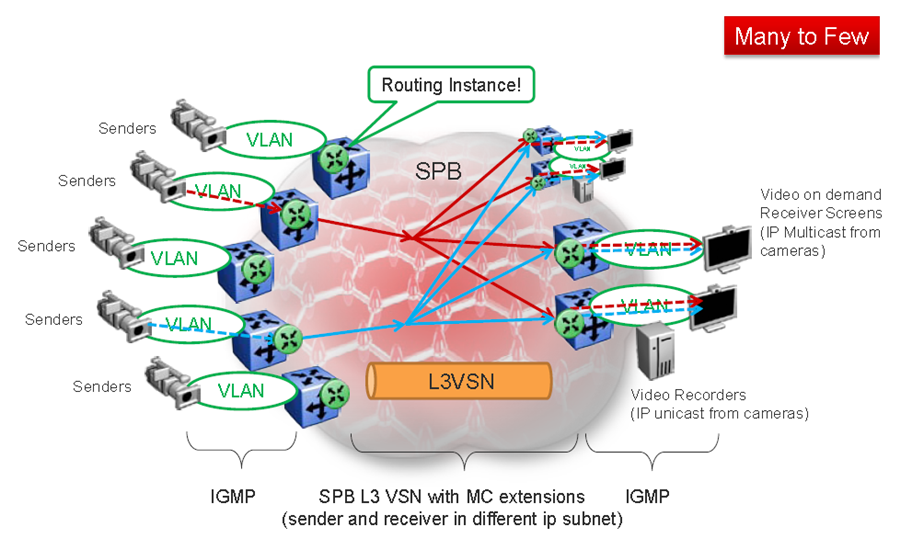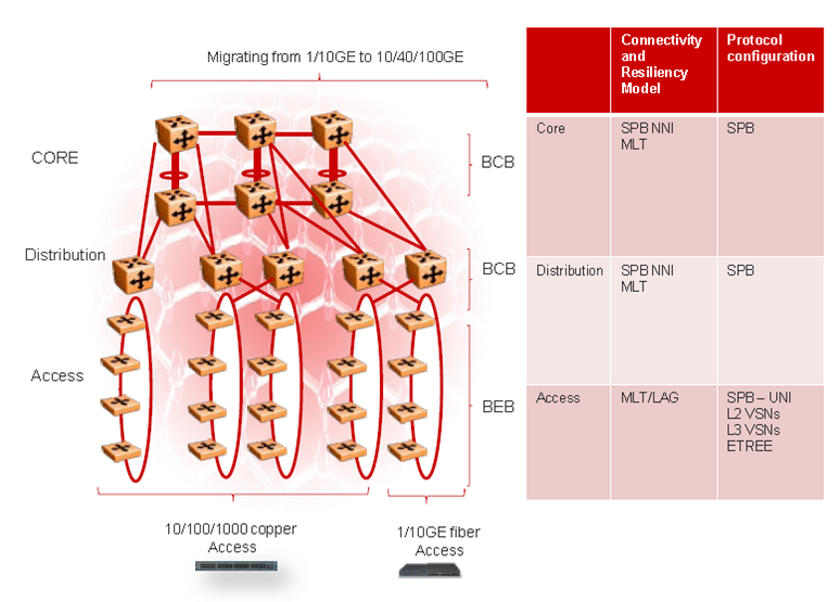Solution-Specific Reference Architectures
The following sections describe solution-specific reference architectures, like for example for Video Surveillance or Data Center implementation, using the VSP 4450 Series.
Multi-tenant — fabric connect
This fabric connect-based solution leverages the fabric capabilities of the VSP platforms: a VSP 7000 core and a VSP 4450 Series edge. This solution provides the ability to run, by default, up to 24 VRFs for each wiring closet and is well suited for multi-tenant applications. The zero-touch core is enabled by the fabric connect endpoint provisioning capabilities.

Note
You can increase VRF scaling to run more than 24 VRFs. The maximum number of supported VRFs and Layer 3 VSNs differs depending on the hardware platform. For more information about maximum scaling numbers, see VSP 8600 Release Notes.
If this solution must support IPv6, then a central router-pair routes all IPv6 traffic. The IPv6 traffic is tunneled from each wiring closet to the IPv6 routers by extending Layer 2 VSNs to the q-tagged router interfaces.

The following list outlines the benefits of the fabric connect-based solution:
-
Endpoint provisioning
-
Fast failover
-
Simple to configure
-
Layer 2 and Layer 3 virtualized
Hosted data center management solution — E-Tree
In some hosted data center solutions, the hosting center operating company takes responsibility for managing customer servers. For this shared management, shown in the following figure, servers that control the operating system level of the production servers, such as the patch level, are deployed. Because customer production servers do not communicate with each other, a distributed private VLAN solution based on fabric connect is deployed to manage all production servers. This solution builds a distributed set of E-Trees for each management domain.
The VSP switches as access, provide an elegant network-wide E-Tree solution. Spokes, or managed servers, cannot communicate to each other over this network, but the shared management servers on the hub ports can access all spokes. Because of the Layer 2 – E-Tree nature of this setup, the managed servers do not require any route entries, and only require one IP interface in this management private VLAN. This solution supports tagged and untagged physical and virtual (VM) servers.

The following list outlines the benefits of the hosted data center management solution:
-
Easy endpoint provisioning
-
Optimal resiliency
-
Secure tenant separation
Video surveillance — bridged
In a video surveillance solution, optimal traffic forwarding is a key requirement to ensure proper operation of the camera and recorder solutions. However, signaling is also important to ensure quick channel switching. This is achieved by deploying a fabric connect based IP multicast infrastructure that is optimized for multicast transport, so that the cameras can be selected quickly, and so that there is no unnecessary traffic sent across the backbone.

The following list outlines the benefits of the bridged video surveillance solution:
-
Easy end-point provisioning
-
sub second resiliency and mc forwarding
-
secure tenant separation
-
quick camera switching
Video surveillance — routed
In a video surveillance solution, optimal traffic forwarding is a key requirement to ensure proper operation of the camera and recorder solutions. However, signaling is also important to ensure quick channel switching. This is achieved by deploying an IP multicast infrastructure that is optimized for multicast transport, so that the cameras can be selected quickly, and so that there is no unnecessary traffic sent across the backbone. In the topology shown in the following figure, each camera is attached to its own IP subnet. In a larger topology, this can reduce network overhead. To increase network scalability, you can attach a set of cameras to a Layer 2 switch that has IGMP, and then connect the cameras to the fabric edge (BEB) which has a routing instance.
In many customer scenarios, surveillance must be separated from the rest of the infrastructure. This can be achieved by deploying a Layer 3 VSN for the surveillance traffic to keep the surveillance traffic isolated from any other tenant.

The following list outlines the benefits of the routed video surveillance solution:
-
Easy endpoint provisioning
-
Optimal resiliency and mc forwarding
-
Secure tenant separation
-
Rapid channel/camera switching
Metro-Ethernet Provider solution
VOSS switches provide an end-to-end Metro-Ethernet Provider solution. Leveraging fabric connect throughout the infrastructure enables a scalable and flexible wholesale provider infrastructure.
This use case extends the Transparent Port UNI functionality to transparently forward any customer VLAN across the services.

The following list outlines the benefits of the Metro-Ethernet Provider solution:
-
Easy endpoint provisioning
-
Optimal resiliency
-
Secure tenant separation

